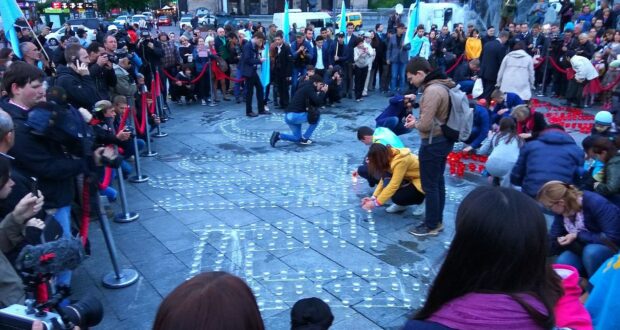26 June, 2023
by Oleksandra Zadesenets, Research Assistant
“Humiliation, beating, torture. Lack of elementary rights. Constant feelings of insecurity and fear. The obsessive desire to be in another, safer place. You might think that I am writing about being in a pre-trial detention centre, but not really. Life in Russia has long become like a prison regime. Freedom of speech in this country is a too expensive pleasure. Sometimes it can cost one’s freedom”, — the note from Crimean artist and activist Bohdan Ziza’s second letter, who was illegally detained in the temporarily occupied Crimea.
On May 18, Ukraine commemorated the Day of Remembrance of the Genocide of the Crimean Tatar People. The accusation of collaboration with the Nazis and the resultant forceful deportation of the Crimean Tatars to the lands of Central Asia is a notorious illustration of the atrocities conducted by the Soviet government during World War II. Regardless of the principle of the equality of nations proclaimed in the USSR’s constitution, during the Soviet occupation, this nation faced the rigorous violation of their right to self-determination, persecution, repression and expulsion from their own land. The policy of deportation, assimilation and suppression of any nationalistic aspirations was a significant feature of Soviet rule, which led to the state where Crimean Tatars became the national minority on their indigenous land.
In his work on post-cold-war history, “From Cold War to Hot Peace: An American Ambassador in Putin’s Russia‘, Michael McFaul noted the transition from the confrontation between communism and capitalism to a new era that spawned the struggle between democracy and autocracy. As a successor of the USSR, Russia inherited not only much of its nuclear arsenal, territorial borders, economic infrastructure and image in the international arena but also adopted elements of the Soviet practice of totalitarian rule. Through the conducting of the referendum on Crimea – which previously had the status of an autonomous republic in Ukraine – becoming part of Russia against international norms, Moscow violated the human rights of Crimean Tatars again and resorted to the repressions of those who did not conform with the imposed Russian rule. As a result, many Crimean dissidents, civil activists and human rights defenders are being imprisoned. For example, on 6 June 2022, Crimean artist Bohdan Ziza was sentenced by a Russian military court to 15 years in a general regime penal colony under the pretext that he had carried out a terrorist attack – although in reality it was for his artistic expression protesting against the Russian war on Ukraine. There is evidence that before his sentence, he was tortured and forced to record a confession video.
This article intends to provide an account of the historical discrimination faced by the Crimean Tatars under Soviet rule and draw parallels to their continued human rights violations in the modern era executed by Russia. By emphasising this recurring pattern, the article aims to highlight the importance of international attention regarding these issues and the urgent need for appropriate actions to address and combat them.
To commence with, Soviet rule was initially forcefully imposed on the Crimean territory, and any signs of national movements were swiftly suppressed. In order to establish their puppet government on the Crimean territory, Bolsheviks forcefully eliminated the national Crimean Tatar leader, Celebi China, and implemented the mechanisms of elite cooptation and Soviet propaganda, which subjected the peninsula to exclusively Soviet rule. An exact parallel can be drawn between the manner Russia established its governance following the occupation of Crimea in 2014. For instance, Sergey Aksenov, the leader of the Russian Unity Party, which had low support among the Crimean population prior to the occupation, was appointed as the head of the regional government of Crimea. He was a figure whose actions were orchestrated by the Kremlin, and aimed to popularise the narratives of the Russian propaganda and legitimise the infringement on Ukrainian sovereignty. Both the USSR and Russia intended to consolidate control and legitimise their illegal actions by eradicating national leaders and placing individuals loyal to their governments in control.
The Soviet government committed genocidal actions towards the Crimean Tatars population. According to the II Charter of the Convention on the Prevention and Punishment of the Crime of Genocide, genocidal actions can be considered as such when they are ‘deliberately inflicting on the group conditions of life calculated to bring about its physical destruction in whole or in part‘. Regardless that many Crimean Tatars served in the ranks of the Red Army, after the exhausting and bloody Battle for Sevastopol, the Soviet government accused Crimean Tatars of collaboration with the Nazis and started their forceful mass deportation to Central Asia. Many Crimean Tatars perished on the way to the lands of their expulsion, as the Soviets subjected them to extremely harsh conditions. Some scholars, including Brian Glyn Williams, argued that this policy was designed to cleanse the USSR’s borderlands of non-Slavic, predominantly Islamic, populations. After the retreat of the Nazis, the NKVD initiated a campaign they referred to as “cleaning up” the southern borders of the Soviet Union following the forceful deportation of other Muslim minority groups, such as Chechens, Karachais and Ingush. Thus it is reminiscent of the Nazi legacy, which was internationally condemned in the Nuremberg trials.
The fate of Crimean Tatars was undecided at the time of their deportation, and they ceased to exist as citizens of the Soviet state. In 1945, the Soviet authorities abolished the autonomy of the Crimean ASSR. The migration system of Russian settlers to territories after having had the indigenous population removed was a prominent agenda in the Soviet colonisation policy. It resulted in the assimilation and marginalisation of the Crimean Tatar nation. Their national identity was repressed and substituted by the so-called ‘Soviet’ identity, which in practice resembled the ideology of Russian imperial nationalism. Crimean Tatars were persecuted for their national and religious practices, which contradicted the Soviet ideology. Even after the right to repatriation obtained by Crimean Tatars in the Glasnost era, political participation and representation were inadequate: they faced discrimination on their historical land, and their right to self-determination was disregarded. For example, Crimean Tatars’ national leader Mustafa Dzhemilev was imprisoned by the Soviet state for his advocacy for the rights of the Crimean Tatar People for 15 years. This history repeated itself in the modern era with another Russian dictator – Vladimir Putin. Russia targeted Dzhemilev after his opposition to the invasion and issued a ‘sentence’ against him for attempting to enter his native Crimea.
Only during the time of Ukrainian independence established in 1991 did the Crimean Tatars obtain the right to self-government and representation enshrined in the constitution of Ukraine. Never before had they had such a unique opportunity, which created an environment for unobstructed Crimean cultural and political development.
The Medjlis is a representative body of the Crimean Tatars serving as the platform for advocating their interests and rights both on the domestic (Ukrainian) and international levels. However, after the Russian occupation of Crimea in 2014, this body was designated by the Kremlin as extremist, which was followed by the abolition of this institution. As a result, Russia criminalised and imprisoned approximately 2,500 members of the Medijlis and deprived Crimean Tatars of the fundamental rights for representation and self-governance on their own territory. For example, in April 2021, the Russian occupation authorities imposed a fine on Bekir Mamutov, the editor-in-chief of the “Qirim” newspaper, for publishing a report by the UN Secretary-General that mentioned the Crimean Tatar Majlis.
As the Crimean Platform states, the ban and consistent oppression of the Crimean Tatars’ religious, cultural, political and media structures destroyed the whole system of their national institutions. The Observatory for the Protection of Human Rights Defenders recorded arbitrary detention and judicial harassment of Nariman Dzhelyal, a journalist, defender of indigenous rights and the first deputy head of the Crimean Tatar Mejlis. Furthermore, the FSB fabricated an allegation against a 20-year-old teacher of the Crimean Tatar language Appaz Kurtamet, who was accused of financing an illegal armed group, which resulted in giving him ten years of imprisonment.
Similarly to how the Soviets accused Crimean Tatars of being Nazis, Russians promote the narrative by labelling them as extremists. They claim that their national organisations are a direct threat to justify their oppression. It is vivid evidence of the violation of international humanitarian law and human rights. Moreover, it is a clear manifestation of racial discrimination and an attack on cultural heritage.
The significance of international condemnation concerning the repressions of Crimean Tatars and unlawful Russian actions cannot be overstated. There is an urgent need to shed light on these atrocities and gain international recognition to combat them, ensuring human rights adherence decisively. With the involvement of the human rights protection institutions and through putting pressure on the responsible governing bodies, the support and protection of Crimean Tatars should be empirically demonstrated. Only this will make clear that there is no room for the minority groups’ suppression and international law and human rights violations in the XXI century.
Image: An event commemorating the victims of the Crimean Tatar deportation in Kyiv in 2016 (Source: Visem via CC BY-SA 4.0)
 Human Security Centre Human Rights and International Security Research
Human Security Centre Human Rights and International Security Research




